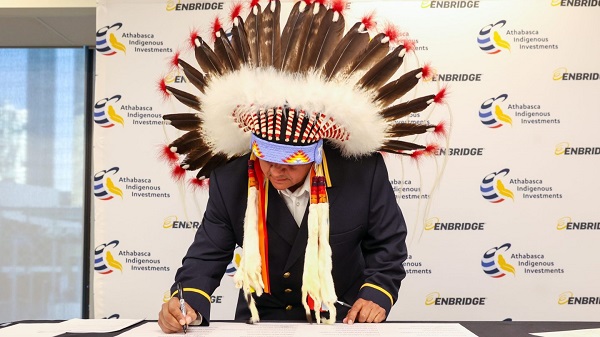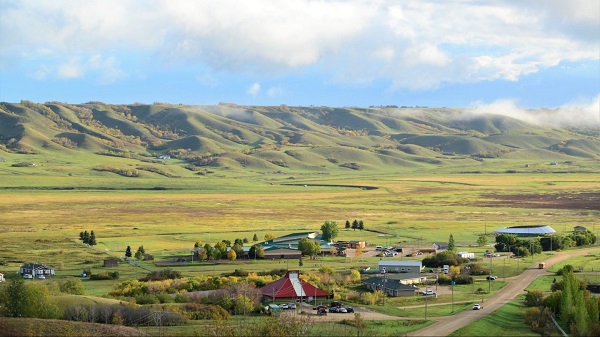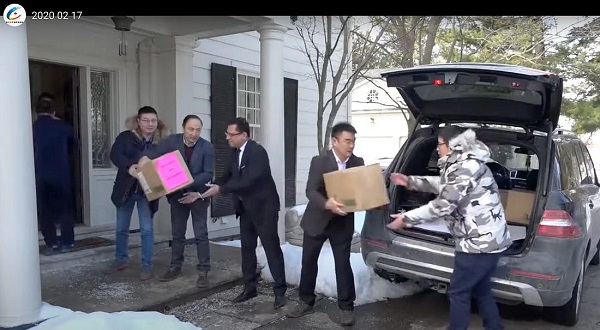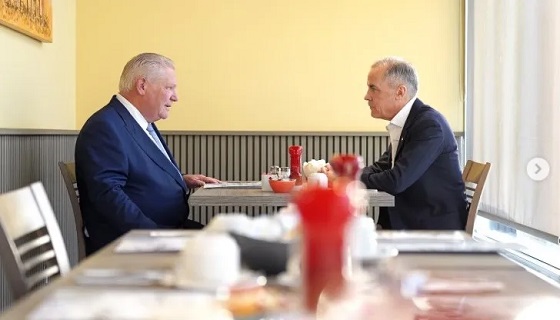Canadian Energy Centre
Experts urge caution with Canadian energy in response to Trump tariffs

From The Canadian Energy Centre
By Will Gibson
‘We want Americans to stand up for our supply’
A lawyer by training, Gary Mar is also a keen student of history. And he recommends Canadians look at what happened when past U.S. administrations imposed tariffs on imports before jumping to add costs to Canadian energy.
“President Richard Nixon imposed a 10 per cent tariff in 1971 and withdrew it after a few months because it caused so much pain for American consumers,” says Mar, CEO of the Canada West Foundation, who served as Alberta’s trade representative in Washington from 2007 to 2011.
“Canadians and their governments need to be patient. Any tariffs on energy will be passed on to consumers in the United States. We shouldn’t let the president off the hook for raising the price to American drivers by putting more duties on energy we export,” he says.
“We want Americans to stand up for our supply, not displace the anger with President Trump for raising prices with anger towards Canadians.”
A major U.S. supplier
The U.S. imports more than four million barrels of oil per day from Canada, or about one out of every five barrels the country consumes. Most Canadian imports are destined for refineries in the U.S. Midwest including Illinois, Indiana, Michigan and Ohio.
About 99 per cent of natural gas imports into the United States also come from Canada. Natural gas imports flow primarily to Idaho, North Dakota, Minnesota and Montana, according to the U.S. Energy Information Administration.
Trump tariffs
Nixon put tariffs in place in an attempt to weaken the U.S. dollar against foreign currencies and strengthen U.S. exports.
Mar, who served as cabinet minister in the Klein and Stelmach governments from 1993 to 2007, sees Trump’s tariffs as aimed to repatriate manufacturing and jobs to America.
“President Trump made this explicitly clear…if you want to sell manufactured goods in the United States, you need to move your factories here,” says Mar.
“But Canadian oil and natural gas are key inputs that help U.S. manufacturing. We ship the products or partially refined products that support manufacturing of finished products in the United States. Tariffs will raise those costs for U.S. manufacturers and ultimately American consumers.”
A divisive rerun of the National Energy Program?
Mar’s former cabinet colleague Ted Morton agrees Canada needs to exercise patience and caution in any response to U.S. tariffs.
Morton, who served as an Alberta cabinet minister from 2006 to 2012, strongly disagrees with the idea of placing countervailing tariffs on energy exports to the United States. Morton casts it as a divisive rerun of then Prime Minister Pierre Trudeau’s controversial National Energy Program in the early 1980s.
Energy export tariffs “would be an attempt to revive Liberal Party support from disillusioned voters in Ontario and Quebec,” he says.
“The biggest loser in Trump’s new tariff war will be Ontario due to the integration of the auto sector between the U.S. and Canada. It’s simple political arithmetic. Ottawa could collect $4 or $5 billion by taxing energy exports in western Canada and send that money to prop up struggling industries in Ontario and Quebec,” Morton says.
“Ontario and Quebec combined have a total of 199 MPs, more than enough to form a majority government. It’s the ‘screw the West and take the rest’ strategy. It’s how the Liberals won the 1980 federal election, and they could try it again.”
Legal and constitutional precedents
And while imposing export tariffs on Canadian energy could be politically popular in central Canada, Morton suggests the action would not withstand a legal challenge thanks to legal and constitutional precedents set by former Alberta Premier Peter Lougheed.
“Peter Lougheed left future Alberta premiers with some very effective legal weapons. His government successfully challenged the constitutionality of Trudeau’s export tax on natural gas. He then teamed up with the other western premiers to negotiate a new constitutional amendment that affirms provincial jurisdiction over the development and conservation of natural resources,” Morton says.
“Premier Danielle Smith should win any constitutional challenge if the federal government tries to impose an export tariff on oil or natural gas.”
Morton, like Mar, also counselled patience in responding to tariffs because “Trump’s tariffs on Canadian energy will punish American consumers more than Canadians.”
The national interest
David Yager, who has studied and analyzed energy policy for more than 40 years, agrees tariffs on energy have the potential to drive a wedge between Alberta and the rest of the country in the same way the National Energy Program did.
“The dynamic definition of national interest is what I struggle with. Going back several decades, it was in the national interest to get oil and gas across Canada so there was a drive to build pipelines east and west,” says Yager, a consultant who also serves as a special advisor to Premier Smith.
“Today, the national interest has flipped again, and energy exports are now a source of revenue to save the ‘real’ Canada, which is central Canada. It’s the same kind of logic that has seen the emissions cap on oil and gas as well as the carbon tax.”
If Canada wants to retaliate, Yager recommends putting a duty on the 1.7 billion cubic feet of natural gas imported by Ontario and Quebec from the northeastern United States.
“That would be the appropriate tit for tat response,” Yager says.
“You could build a nice pool of capital and clobber U.S. producers without driving a wedge between Alberta and the rest of the country.”
Canadian Energy Centre
Why nation-building Canadian resource projects need Indigenous ownership to succeed

Chief Greg Desjarlais of Frog Lake First Nation signs an agreement in September 2022 whereby 23 First Nations and Métis communities in Alberta will acquire an 11.57 per cent ownership interest in seven Enbridge-operated oil sands pipelines for approximately $1 billion. Photo courtesy Enbridge
From the Canadian Energy Centre
U.S. trade dispute converging with rising tide of Indigenous equity
A consensus is forming in Canada that Indigenous ownership will be key to large-scale, nation-building projects like oil and gas pipelines to diversify exports beyond the United States.
“Indigenous ownership benefits projects by making them more likely to happen and succeed,” said John Desjarlais, executive director of the Indigenous Resource Network.
“This is looked at as not just a means of reconciliation, a means of inclusion or a means of managing risk. I think we’re starting to realize this is really good business,” he said.
“It’s a completely different time than it was 10 years ago, even five years ago. Communities are much more informed, they’re much more engaged, they’re more able and ready to consider things like ownership and investment. That’s a very new thing at this scale.”
 John Desjarlais, executive director of the Indigenous Resource Network in Bragg Creek, Alta. Photo by Dave Chidley for the Canadian Energy Centre
John Desjarlais, executive director of the Indigenous Resource Network in Bragg Creek, Alta. Photo by Dave Chidley for the Canadian Energy Centre
Canada’s ongoing trade dispute with the United States is converging with a rising tide of Indigenous ownership in resource projects.
“Canada is in a great position to lead, but we need policymakers to remove barriers in developing energy infrastructure. This means creating clear and predictable regulations and processes,” said Colin Gruending, Enbridge’s president of liquids pipelines.
“Indigenous involvement and investment in energy projects should be a major part of this strategy. We see great potential for deeper collaboration and support for government programs – like a more robust federal loan guarantee program – that help Indigenous communities participate in energy development.”
In a statement to the Canadian Energy Centre, the Alberta Indigenous Opportunities Corporation (AIOC) – which has backstopped more than 40 communities in energy project ownership agreements with a total value of over $725 million – highlighted the importance of seizing the moment:
“The time is now. Canada has a chance to rethink how we build and invest in infrastructure,” said AIOC CEO Chana Martineau.
“Indigenous partnerships are key to making true nation-building projects happen by ensuring critical infrastructure is built in a way that is competitive, inclusive and beneficial for all Canadians. Indigenous Nations are essential partners in the country’s economic future.”
Key to this will be provincial and federal programs such as loan guarantees to reduce the risk for Indigenous groups and industry participants.
“There are a number of instruments that would facilitate ownership that we’ve seen grow and develop…such as the loan guarantee programs, which provide affordable access to capital for communities to invest,” Desjarlais said.
 Workers lay pipe during construction of the Trans Mountain pipeline expansion on farmland in Abbotsford, B.C. on Wednesday, May 3, 2023. CP Images photo
Workers lay pipe during construction of the Trans Mountain pipeline expansion on farmland in Abbotsford, B.C. on Wednesday, May 3, 2023. CP Images photo
Outside Alberta, there are now Indigenous loan guarantee programs federally and in Saskatchewan. A program in British Columbia is in development.
The Indigenous Resource Network highlights a partnership between Enbridge and the Willow Lake Métis Nation that led to a land purchase of a nearby campground the band plans to turn into a tourist destination.
“Tourism provides an opportunity for Willow Lake to tell its story and the story of the Métis. That is as important to our elders as the economic considerations,” Willow Lake chief financial officer Michael Robert told the Canadian Energy Centre.
The AIOC reiterates the importance of Indigenous project ownership in a call to action for all parties:
“It is essential that Indigenous communities have access to large-scale capital to support this critical development. With the right financial tools, we can build a more resilient, self-sufficient and prosperous economy together. This cannot wait any longer.”
In an open letter to the leaders of all four federal political parties, the CEOs of 14 of Canada’s largest oil and gas producers and pipeline operators highlighted the need for the federal government to step up its participation in a changing public mood surrounding the construction of resource projects:
“The federal government needs to provide Indigenous loan guarantees at scale so industry may create infrastructure ownership opportunities to increase prosperity for communities and to ensure that Indigenous communities benefit from development,” they wrote.
For Desjarlais, it is critical that communities ultimately make their own decisions about resource project ownership.
“We absolutely have to respect that communities want to self-determine and choose how they want to invest, choose how they manage a lot of the risk and how they mitigate it. And, of course, how they pursue the rewards that come from major project investment,” he said.
Canadian Energy Centre
Saskatchewan Indigenous leaders urging need for access to natural gas

Piapot First Nation near Regina, Saskatchewan. Photo courtesy Piapot First Nation/Facebook
From the Canadian Energy Centre
By Cody Ciona and Deborah Jaremko
“Come to my nation and see how my people are living, and the struggles that they have day to day out here because of the high cost of energy, of electric heat and propane.”
Indigenous communities across Canada need access to natural gas to reduce energy poverty, says a new report by Energy for a Secure Future (ESF).
It’s a serious issue that needs to be addressed, say Indigenous community and business leaders in Saskatchewan.
“We’re here today to implore upon the federal government that we need the installation of natural gas and access to natural gas so that we can have safe and reliable service,” said Guy Lonechild, CEO of the Regina-based First Nations Power Authority, on a March 11 ESF webinar.
Last year, 20 Saskatchewan communities moved a resolution at the Assembly of First Nations’ annual general assembly calling on the federal government to “immediately enhance” First Nations financial supports for “more desirable energy security measures such as natural gas for home heating.”
“We’ve been calling it heat poverty because that’s what it really is…our families are finding that they have to either choose between buying groceries or heating their home,” Chief Christine Longjohn of Sturgeon Lake First Nation said in the ESF report.
“We should be able to live comfortably within our homes. We want to be just like every other homeowner that has that choice to be able to use natural gas.”
At least 333 First Nations communities across Canada are not connected to natural gas utilities, according to the Canada Energy Regulator (CER).
ESF says that while there are many federal programs that help cover the upfront costs of accessing electricity, primarily from renewable sources, there are no comparable ones to support natural gas access.
“Most Canadian and Indigenous communities support actions to address climate change. However, the policy priority of reducing fossil fuel use has had unintended consequences,” the ESF report said.
“Recent funding support has been directed not at improving reliability or affordability of the energy, but rather at sustainability.”
Natural gas costs less than half — or even a quarter — of electricity prices in Alberta, British Columbia, Ontario, Manitoba and Saskatchewan, according to CER data.
“Natural gas is something NRCan [Natural Resources Canada] will not fund. It’s not considered a renewable for them,” said Chief Mark Fox of the Piapot First Nation, located about 50 kilometres northeast of Regina.
“Come to my nation and see how my people are living, and the struggles that they have day to day out here because of the high cost of energy, of electric heat and propane.”
According to ESF, some Indigenous communities compare the challenge of natural gas access to the multiyear effort to raise awareness and, ultimately funding, to address poor water quality and access on reserve.
“Natural gas is the new water,” Lonechild said.
-

 2025 Federal Election2 days ago
2025 Federal Election2 days agoPPE Videos, CCP Letters Reveal Pandemic Coordination with Liberal Riding Boss and Former JCCC Leader—While Carney Denies Significant Meeting In Campaign
-

 2025 Federal Election1 day ago
2025 Federal Election1 day agoNo Matter The Winner – My Canada Is Gone
-

 2025 Federal Election2 days ago
2025 Federal Election2 days agoTrudeau and Carney Have Blown $43B on EVs
-

 2025 Federal Election1 day ago
2025 Federal Election1 day agoASK YOURSELF! – Can Canada Endure, or Afford the Economic Stagnation of Carney’s Costly Climate Vision?
-

 Alberta1 day ago
Alberta1 day agoMade in Alberta! Province makes it easier to support local products with Buy Local program
-

 Alberta1 day ago
Alberta1 day agoProvince to expand services provided by Alberta Sheriffs: New policing option for municipalities
-

 2025 Federal Election1 day ago
2025 Federal Election1 day agoCSIS Warned Beijing Would Brand Conservatives as Trumpian. Now Carney’s Campaign Is Doing It.
-

 2025 Federal Election1 day ago
2025 Federal Election1 day agoInside Buttongate: How the Liberal Swamp Tried to Smear the Conservative Movement — and Got Exposed





